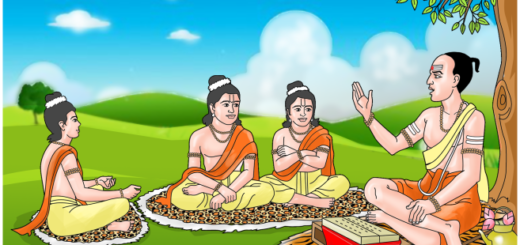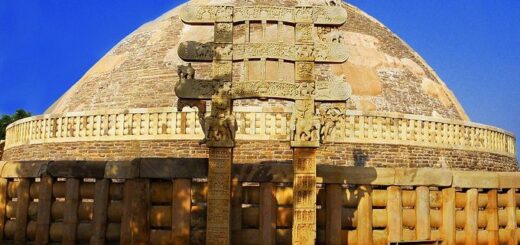Art & Culture: Medieval School of Sculpture
by
Mentors4ias
·
May 7, 2019
Introduction:
- Instead of the classical dignity, sobriety and simplicity, the sculpture is now more and more tending towards ornamentation, creating highly ornate art objects, with strange and unusual imaginary creatures, such as half human, half monsters, etc.
- The characteristic of this new form of style of art is the difference with classical art in attitude, if not in skill and aptitude.
- There is more complication, ornamentation and enrichment. There is an erroneous view that the Indian artist was a strict conformist with the rules laid down in the shilpasastras specifying how the gods of the Indian pantheon are to be shown in images.
- One look at the variety and individuality of Indian sculpture will clearly demonstrate that as styles went on developing the sculptors frequently departed from the texts and rules laid down, and delighted in those departures and the liberties they took with the bodies of humans and even of gods and goddesses.
- This will be abundantly clear if we compare any two images of a given deity, such as the Buddha image. The sculptor had attained sufficient dexterity, maturity and skill to be able to infuse a certain individuality in his work of art, a stamp of his own likes and dislikes tastes of the period, his own predilections.
- This is a sign of maturity, of life, of dynamism. Strict uniformity, ingenuity and conformity with the rules laid down in the shilpasastra texts during the ages would be a sure sign of the decadence of this great art in the country.
- The most remarkable achievement of the new artist of this age was to contribute a dreamy, floating quality to the figures of the flying gods and freer movement than in the classical period; on the other hand there is a tendency towards increasing elegance and slenderness of form.
- There is a new beauty in women. The hips are more slender, the waist more supple, the legs longer. The face still continued to be stylized and the breasts full and firm. The woman is no longer the mother goddess but a divine charmer.
- One such superb example of the sculptor’s art is a lovely figure of Vrikshika, or a celestial damsel, from Gyraspur, in Gwalior, standing in a gracefully flexed pose, against a tree. She is decked in ornaments and attired in a finely patterned drapery which produces an effect of rightly decorated silk. Her coiffure is artistically arranged.
The Gujara Pratiharas:
- The Gurjara Pratiharas had a vast kingdom that embraced the territory of Gujarat, Rajasthan, Uttar Pradesh. Their rule in the 8th, 9th and 10th centuries saw a great cultural renaissance.
Palllavas:

- An artistic movement of great importance flourished under the aegis of the Pallava rulers of Kanchi and they are credited with having built the seven monolithic pagodas, the rathas, in Mahabalipuram. Some of the outstanding sculptures that are credited to their patronage are the Mahishasuramardini in relief, Girigovardhana panel, Arjuna’s penance or the Descent of the Ganga, Trivikrama Vishnu, Gajalakshmi and Anatasayanam.
- In the annals of Indian art there is perhaps no better example of the representation of the Elephant than that in the Arjuna’s penance scene. The celestial world, the temporal world as well as the animal world has been shown with masterly skill.
- Apart from the celestials there are hunters, sages, disciples, wild animals like the lion, tiger, elephant and bear. The representation of these animals is very naturalistic and shows delightful delineation of line. The radiation of peace and calm by the sages is reflected in a meditating cat around which a number of rats are frolicking.
- Close by to the South-West of the Ganesha Ratha and behind Arjuna’s penance is the cave known as Varahamandapa, a fine specimen of its type.
- The hall at the front has two-lion pillars and two pilasters and beyond this, in the center, is the cell guarded by two Dwarpalas.
- One of the panels represents Varaha raising the Earth from the ocean, wherein she was submerged. A remarkable feature is that the snout of the boar has been modelled with great care and the head of the animal has been handled with such dexterity that it blends in a natural way with the human contour of the rest of the figure in the panel.
- Surya, Brahma, Rishis and the goddess Prithvi are shown surrounding and adoring Varaha. The right foot of Varaha rests on the hoods of the Naga king Sesha. The delineation of lotus leaves and flowers and ripples suggests water.
- In all these examples the vigour of the composition is unique.

- The Pallava style concerns itself with a tall and slender physiognomical form. The thin and elongated limbs emphasise the tallness of the figure.
- A great masterpiece is the carving from Mahabalipuram showing the great goddess Durga engaged in a fierce battle with the buffalo headed demon aided by their respective armies. Riding on her lion she is rushing at the powerful demon with great courage. He is moving away, yet watching for a moment to attack.
- It represents the eternal struggle between the forces of good and evil, in which the good ultimately triumphs. The dramatic movement, emotional intensity and visual realism noticed in this sculpture are worthy of a master craftsman.
- The high and cylindrical crown of Vishnu, heavy drapery, thick cord at the waist with prominent loops and tassels, and the mode of wearing the under-garment are all Pallava characteristics worthy of note.
Rashtrakutas:
- In the middle of the 8th century the Rashtrakutas wrested power from the Chalukyas. They created the greatest wonder of medieval Indian art in their Kailasa temple at Ellora. Quarried out of a hill and solid rocks, it is sculptured on a grand scale.
- The bold and magnificent carving in this temple shows the Rashtrakuta style of tall and powerfully built figures, reflecting with spiritual and physical poise.
- The beautiful architectural rock sculpture from Cave No.29 at Ellora shows the marriage of Siva and Parvati. Siva holding the hand of the bashful Parvati occupies the centre of the composition. To the right Brahma, the creator, is actively engaged in stirring up the flames of the sacred fire. The parents of Parvati stand behind her to offer their daughter to the great god. A number of gods assembled to witness the function are shown hovering above the principal figures. The dignified grace of the divine couple and the gentle solemnity of the occasion have been portrayed by the sculptor with a masterly skill.
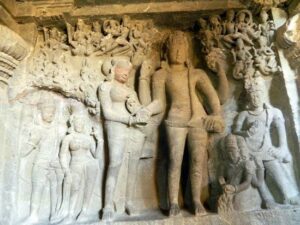
- Another magnificent sculpture at Ellora is a panel depicting Ravana shaking mount Kailasa. In this remarkable scene the quivering of the mountain can be felt, and Parvati is shown greatly agitated, turning to Siva, grasping his hand in fear while her maid takes to flight but the Great God is unmoved and holds on fast, pressing down the mountain with his foot. The lower half of the composition exhibits Ravana exerting all the force of his twenty arms against the mountain.

- A classic panel showing the king of the Naga and his queen, belonging to Ajanta, 5th century A.D. shows them seated on a throne attended by a hand maiden. The sculptural work at Ajanta merits as great attention as the world famous wall paintings.
The Vakatakas:
- The Vakataka traditions are derived from the earlier Satavahana which can be clearly seen in the many carvings of Ajanta and in the painted and carved figures at Ajanta.
- It is only the decorative elements, chiefly composed of pearls and ribbons, so characteristic of the Gupta-Vakataka age, that distinguishes them from the simpler, but notable sculpture of Amravati.
- The cave-shrine at Elephanta is another great monument of the Rashtrakutas, which contains the famous The three heads emanating from one and the same body represent three different aspects of Lord Shiva. The central face with a calm and dignified appearance shows him as the creator, the one on the left, with a severe look, portrays him as the destroyer and the third, to the right, with a calm and pacific expression.
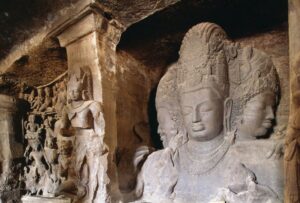
Cholas:
- The Mighty Cholas who succeeded the Pallavas and ruled over South India from the 9th to 13th centuries A.D. created the great temples at Tanjavur, Gangai Kondo Cholapuram, Darasurama, which are a veritable treasure house of their art.
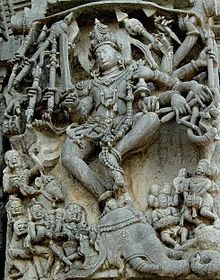
- At the Brihadesvara temple at Tanjavur which is the most mature and majestic of the Chola temples, sculpture there has attained a new maturity which is evident in the gracefully modelled contours of the figures, their flexed poses, delicate ornamentation, pleasing faces and a certain freshness, all of which add charm to the work. Chola art not only influenced the art of Ceylon, but it travelled as far away as Java and Sumatra.
- A good example of Chola craftsmanship in the 11th century is the relief carving of Siva as Gajsurasamaharamurti. The irate god is engaged in a vigorous dance of fierce ecstasy after having killed the elephant-demon, who has given so much trouble to the rishis and his devotees. The hide of the demon is spread aloft by the god, using it as a sort of cover. Devi stands at the lower right corner as the only awe-struck spectator of the divine act of retribution.
- The later phase of Chola art, in the 13th century, is illustrated by the sculpture showing Bhudevi or the earth goddess as the younger consort of Vishnu. She stands in a gracefully flexed attitude on a lotus base holding a lily in her right hand, while the left arm hangs along her side in lolahasta.
Chandellas:
- The Chandellas, who ruled from 950 to 1100 A.D. constructed towering temples in central India, like the Kandariya Mahadev temple at Khajuraho. These were sculpted with human representations of endless variety. The sculptor here preferred the slender taller figures with a considerable accentuation of linear details.
- A charming specimen of the Chandella art of the 11th century is this figure of a woman writing a love letter. On either side of her stands an attendant.
- Equally fascinating is the graceful celestial beauty shown standing under a stylised mango tree. Holding a mirror in her hand, she is applying her make-up and getting ready to meet her lover.
- Two diminutive figures stand in attendance, carrying the toilet requisites in a bag and a satchel. This sculpture is datable to the 11th century A.D. The magnificence, perfection of design and sculptural profusion at Khajuraho is outstanding in Indian Art.
- Gods, goddesses, apsaras, men and women standing or seeming to be in action, with their well developed and voluptuous bodies, stand liberated from their frames, to emerge in a living world of their own.
Pala Rulers:
- Great impetus was given to art under the reign of Pala rulers in Bihar and Bengal during the period 730 to 1110 A.D. They were Buddhist by faith.
- They greatly encouraged centres of learning like Nalanda and Vikramasila, where the stupas and monasteries gave ample scope for the sculptor’s expression of an art which found stimulus in religion. During this period art reached technical perfection.
- The Pala Style is marked by slim and graceful figures, elaborate jewellery and conventional decoration.
- Their sculptures from Bihar are somewhat thick set and heavier in their general proportions of limbs than those from Bengal. The Pala rulers had intimate relations with Java which are evident in Hindu-Javanese sculpture, and painting of Nepal, Kashmir, Burma and Thailand.
- Some amount of stylisation is noticed in the later phase of Pala art, but the tradition is continued under the Sena rulers in the 12th century until the Islamic rulers overran the country.
- An excellent specimen from Mahanad in West Bengal is this lovely figure of the personified river goddess Ganga. She stands gracefully under a tree, Kalpataru, on a lotus, holding a water-vessel in her hand, symbolising prosperity and plenty. The ends of her scarf draped around the arms, trail on either side. She is adorned with profuse jewellery and wears a lower garment reaching to the ankles. The figure is expressive and the workmanship is of a high order.
Eastern Ganga Dynasty:
- The kings of the Eastern Ganga dynasty who held sway in Orissa from the 7th to the 13th centuries have left monumental temples at Bhubaneswar, Puri, and Konarak which are richly embellished with wealth of sculptures.
- By the middle of the 9th century A.D. especially in Orissa, there developed a school of sculpture which, among other things, took sensuous delight in the lovely forms of women. There are numerous sculptures of beautiful female figures on the face of walls.
- The Orissan temple has many such representations of young and charming creatures with a seductive smile, luxurious hair full of jewellery, they are, called
- Similar lovely women are seen to appear everywhere as if growing out of trees and creepers, themselves like beautiful flowers and vines, often holding on to branches of trees and standing on floral ornaments.
- Most of them are standing in various dance poses.
Konark Sun Temple:
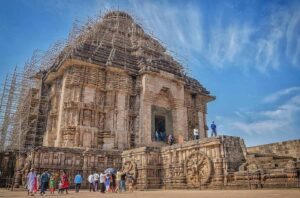
- The famous temple at Konarak, was built by Narasimhavarman in the middle of the 12th century and dedicated to Surya or the sun-god. It has been conceived as a huge stone chariot on immense wheels, dragged by seven rearing horses.
- The temple is now partly preserved. Its presiding deity, the sun-god as seen here, is depicted in the typical north Indian manner, wearing boots, chain-mail armour, holding a lotus in each hand. He is riding a chariot driven by seven horses. On each side are his two wives, Chhaya and Suvarchasa, and the attendants Danda and Pingla. The figures above are shooting arrows to dispel darkness.
- On the plinth of the Jagmohana of the temple, at a height of about 50 feet from the ground, are installed colossal celestial musicians facing in all directions, playing on different musical instruments. These celestial maidens are shown playing the Veena. The massive proportions and powerful modelling of the figure, and a gentle smile on her face, express a sense of harmonious delight.
- Another celestial maiden, similar to the Veena player, is this drummer. They are all in pink coloured sandstone of a rough texture. These figures are of colossal proportions yet very elegantly and beautifully carved.
- There are, besides, serious scenes where a teacher is shown surrounded by his students, in animated postures, full of life.
- Narasimha, the great builder of the Konarak temple is shown here on a swing in his harem, surrounded by beautiful women and listening to music.
- Another scene shows him appreciating literature in an assembly of poets patronised by him. Yet another shows his tolerance for faiths by presenting him before Siva, Jagannath and Durga. There are several other similar representations of his life, and Konarak, with its rich sculpture, may be considered a storehouse of 13th century culture in Orissa.
- The image of Surya from the Sun Temple at Konarak drawn by seven rearing horses, one of which fully caparisoned, is of monumental proportions.
- The Orissan artist without giving up the conventional lines of grace and vigour, produced images which were faultless in the perfection of their form and vitality. The examples of this school have sensuous charm and beauty of form. The Mithuna, or a pair of amorous lovers, glows with the exuberance characteristic of Orissan art. They have the eternal smile of lovers who are absorbed in each other. In point of time as well as technique, Orissan art culminates in the famous Sun-temple at Konarak.
Gujarat:
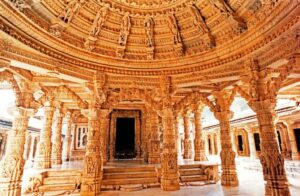
- The traditions of the marble sculpture of Gujarat in Western India are seen in the profusion of intricately carved sculptures which decorate the Jain temples at Mount Abu, Girnar and Palitana.
- The beautiful image of the four-armed Vishnu, the Hindu god of preservation, was fashioned in the 13th century A.D. under the characteristic attributes, that is the mace, the discus and conchshell.
- The hand which hold the lotus is now lost. The weapons are again shown as personified attendant figures on the base. On either side are seen the conventional decorative motifs, and the miniature image of Brahma and Siva, within rectangular niches.
- The Dilwara temples at Mount Abu are the outstanding productions of the western school in the Jain tradition. They are not monuments of architecture, but are sculptural master-pieces, placed one upon the other to fashion one of the sculptural wonders of the world. The ceiling of the
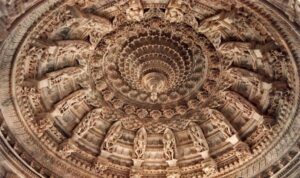 Dilwara temple, especially, is one of the world’s master-pieces of intricate sculptural carvings.
Dilwara temple, especially, is one of the world’s master-pieces of intricate sculptural carvings.
The Hoysalas:
- The Hoysalas were another South Indian dynasty who asserted themselves in the Mysore region about the beginning of the 12th century.
- The temples they built at Halebid and Belur look like lace work in stone. The decoration is elaborate, the emphasis being more on ornamentation than movement or the grace of the human body.
- Hoysala sculptures are somewhat squat and short, highly embellished, or almost over-loaded with ornamentation, but yet are pleasing to behold.
- A splendid example of the Hoysala sculptural art is portrayed in the carving showing Lord Krishna holding aloft the mountain Goverdhana to save the inhabitants of Gokul from the wrath of Indra, who let loose torrential rains to teach them a lesson for their insolence, in paying homage to Mount Goverdhana instead of worshipping him.
- The Mountain with its forest and animal kingdom is held aloft by the youthful Krishna on his left hand, sheltering the entire population of Gokul, including the cows.
- By 13th century A.D. love for the beauty of the human figure has been completely smothered. The artist takes delight no more in the depiction of the beauty of the handsome male or the loveliness of the female body. On the contrary the human body almost completely disappears under a fantastic mass of decoration and ornamentation which become more important than the human figure.
- In the sculpture of the period showing a woman holding a fly-whisk and other figures, we come to the almost total disappearance of the body. Ornamentation has truly run riot. The belt, the necklaces, the crown, the armlets and bracelets even the tree behind and above her is changed into a fancy scroll work of drapery.
Vijayanagara Sculptures:
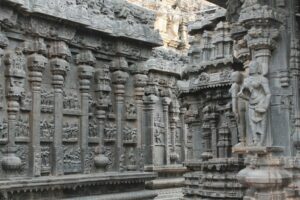
- The last great Hindu Kingdom in South India was of Vijayanagara. During this regime, from circa 1336 to 1565 A.D. several beautiful temples were erected at places like Tadpatri, Hampi, Kanchipuram, etc.
- Carving in these temples show the Chola and Chalukyan art traditions. During this period representations in narrative forms of the Ramayana and Krishna Bal Lila became favourite themes. The Vijayanagara emperors caused excellent portraits to be carved by the sculptors to immortalise them in the vicinity of their favourite deities.
- One such fine example is of Krishnadevaraya at one of the Gopuras at Chidambaram. The final flicker of this however, is seen in the amazingly virile sculpture in titanic proportions carved by the sculptors of Tirumylnayak, and the Gopura and the courts of Meenakshi temple at Madurai.
- The 17th century was a great period of titanic work under the Nayaka of Madurai and Tanjavur.
- During this period the animal motif with fantastic detail as seen in the outstanding sculpture at Srirangam temple in Trichinapally, may be seen. Though, stylised, this art is full of vitality.
- A pair of rampant, furious horses whose heads support the pillars, are carved with great skill and vigour. The riders are shown in realistic poses trying to control them. Each sculpture is realistic though the conception is fantastic.
The Decline:
- Though traditions of stone sculptures continued, no major sculpture movement survived under the Mughal and the other Muhammadan rulers Under the Muhammadan rulers great impetus was given to architecture, but sculptures are rarely found and even those available are products of local chieftains. During the British regime no proper patronage was provided to sculptors and the whole tradition of Indian art almost came to a standstill.





Tags: 2015 police sub-inspector karnatakabest kas material in bangaloreiasIpsips study materialsstudy materials for ias
You may also like...








 Dilwara temple, especially, is one of the world’s master-pieces of intricate sculptural carvings.
Dilwara temple, especially, is one of the world’s master-pieces of intricate sculptural carvings.

